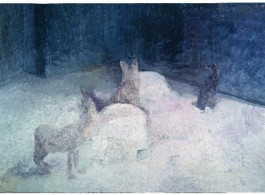On December 15, 2012, Tang Contemporary art is proud to present Strayed Representation, a group exhibition curated by Fu Xiaodong, which represents the middle generation of artists exploring the linguistics of the image in China today. This exhibition is divided into two parts. The exhibition at Tang Contemporary Art features Wang Yin, Wang Xingwei Li Dafang, Qin Qi, Zhang Hui, Ouyang Chun, Yang Jiecang, Lü Shanchuan, Hou Yong, Wang Jun, Wang Fenghua, and Shen Liang. The exhibition at SZ Art Center will be showing the work of some younger artists, including Huang Jingyuan, Shuangfei Arts Center, Bian Ka, Han Jianyu, Liu Guangguang, Liu Xun, Sha Zijian, Tang Yi, and Shang Chengxiang, Wang Chunli, and Wang Rongzhi. Through a study of the representation of an image, this exhibition attempts to more deeply observe the artists’ individualized systems. From its philosophical inception, humankind has continually reflected upon representation and debated representation existing between as wholeness and fragmentation, between multiplicity and unity, and between revealing and concealing. Representation is the result of re-creation; it is the true world hiding itself. Artists repair images and language, then immediately build their own systems of semantic integration; they then briefly reach a consensus, and immediately diverging to forge their own expressive paths.
The artists in this exhibition focus on the exchanges between the things that an image covers and a set of words; the image thus becomes linguistic rhetoric. The artworks are situated between form and content, between the visible and the readable, between imitation and intention; images are blended like texts. Image and text presuppose each other and ensnare each other, thereby becoming a structure full of instability and diversity; these artists have transformed painting into an understanding of the history of painting. These artists also sample from their individual, concrete, partial, and authentic experiences. Based on the reorganization of language and individual experience, artists create extremely personalized systems; through their art, they re-interpret the world and art historical judgment. With the aid of each artist’s individualized system, images once again return to the world of language and become representation. They cautiously use representation, capturing an identifiable image through imitation and concealing its original intention, thereby making visible things invisible. The distance and mutual concern between artworks clearly presses out ideological continuity and likeness, such that it echoes, overflows, and soars; it is thought as painting.
In the works in this exhibition, the artists meticulously disassemble the meaning carried by form, then recombine and restructure it. The meaning of form has moved through many hands, becoming a dismantled poem of image and form. Artworks become the presentation of thought, reorganized within an individual logic system. Form crumbles, along with its original and singular symbolic logic, thus subverting the comprehension patterns for viewing paintings in our intellectual structure. Language challenges the explicit features and habitual names of images and complex contradictions empty out the continuity between language and image, ensnaring viewers’ minds in the peculiarities of these works. As a result, we expect and believe that this exhibition will be an intellectual journey of visual representation.



